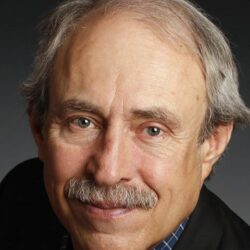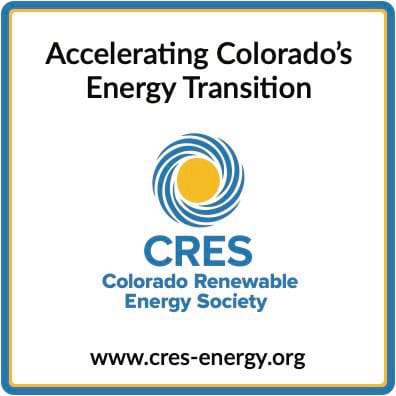Colorado Electric Transmission Authority adopts short list of projects in and beyond Colorado for further study
by Allen Best
When they created the Colorado Electric Transmission Authority in 2021, state legislators gave it a mission that can be summarized in two words: build bridges.
Or, if possible, upgrade the existing bridges of electrical transmission as necessary to help Colorado achieve its 2050 goal of a net-zero emissions economy while satisfying escalating demand.
Directors of CETA have now embraced a short list of potential projects that align with this mission and may get further study, if CETA can find partners to finance the study.
Several projects consist of upgrading existing transmission lines. But two would yield transmission lines in new places, likely triggering concerns about impacts to endangered species. And three of the projects would involve deliberate attempts to strengthen Colorado’s transmission capacity beyond its existing borders.
Colorado is rectangular, 380 miles by 280 miles. In terms of electricity, though, it is best understood as an island. There are bridges from Colorado to other states, but they are limited. For Colorado to go far deeper into decarbonization of electricity, bridges from this island must be created to balance demands with supplies within and beyond its borders. More common will be renovating, rebuilding and reconditioning existing transmission lines.
CETA reported to state legislators that 80% of Colorado’s needs could be met by upgrading 2,000 miles of existing lines or adding 550 miles of new transmission lines, called greenfield development.
New or upgraded transmission lines beyond the state’s borders would gain Colorado access to renewable resources across a broader area, encompassing multiple time zones and different weather systems. Improved transmission east and west would achieve that — or going north or south before heading west or conceivably east.. CETA has explicit authority to help create transmission outside Colorado to serve the state’s needs.
Utilities build electrical transmission, of course. Xcel Energy, the state’s largest electrical utility, is constructing a $1.7 billion transmission project called Colorado Power Pathway. All 550 miles will be east of I-25. Tri-State Generation and Transmission has recently completed or is now building several shorter transmission segments, also all in eastern Colorado.
In building transmission, utilities commonly serve their own interests or at least those of their members and customers. In creating CETA, legislators saw need for a quasi-independent group, not a state agency, to ferret out potential partnerships with existing utilities. It also provided CETA with a powerful but narrow set of tools to get necessary projects done that Colorado’s utilities, for whatever reason, have not and may not on their own.
CETA has little money to work with, just an annual $500,000 legislative allocation for administration of the organization. It has about $150,000 annually in discretionary income. Even for studies, that does not go far. Above all it must be strategic.
Transmission lines are notoriously expensive to build. That same report to state legislators in January said $4.5 billion in investments in transmission will be needed during the next 20 years to achieve the state’s clean energy goals, meet growing electricity demand, and integrate the changing resource mix of utilities.
Legislators did give CETA authority to issue revenue bonds and it can also exercise the power of eminent domain. These might be of value to CETA’s partners once specific lines had been identified and electrical utilities also want to pursue them. Again, finding the partners is the first step.
At a meeting held July 10, directors embraced the short list of projects recommended by Maury Galbraith, the executive director. The handful of lines were culled from a list of three-dozen examined by consultants and then reviewed by 16 utilities, environmental groups and other organizations.
Most of the lines recommended for further study lie in the western half of the state. Two would connect to lines going westward into other states. However, one other project would focus on improving transmission capacity from eastern Colorado into Wyoming, one of the most congested paths in the West.
The projects are:
Pueblo to Montrose to New Mexico
Three of them can easily be lumped together as they are connected, and all of them would use existing rights of way and transmission paths but would be upgraded. Looking at this from east to west (and then south), the new transmission would go:
- from the Pueblo-Colorado Springs area west to Poncha Springs,
- then to Curecanti, the electrical generating dam on the Gunnison River, and Montrose.
- From Montrose, the improved line skirts the western side of the San Juans Mountains to a destination in northwestern New Mexico at Shiprock.
Altogether these lines would upgrade and enlarge carrying capacity using existing transmission corridors across 353 miles. This work is estimated to cost nearly $1.5 billion.
San Luis Valley
A far shorter but likely more difficult work would be a new line from the Alamosa area north across Poncha Pass, a distance of 64 miles. Cost is an estimated $307 million. Both Xcel and Tri-State have existing lines across the pass, but those lines have small capacity.
The valley has some of Colorado’s best solar potential. It also has important habitat for Gunnison sage grouse. Many commenting organizations noted that this wildlife issue could pose a challenge. And the Office of the Utility Consumer Advocate questioned whether the gained solar would outweigh the cost.
Craig to Coyote substation
This 345-kilovolt line would be relatively short, 38 miles, connecting the substations at the existing Craig coal-fired power plant to intersect a new substation called Coyote along a major new transmission line across the northwest corner of Colorado called Gateway South.
The 416-mile Gateway South transmission line built by PaciCorp, a utility, delivers wind-generated electricity from the area around Medicine Bow, Wyo., to central Utah, where it can then be shipped to other markets in Arizona, Nevada and California. The 500-kV line was completed in November 2024.
Like the San Luis Valley, though, this area north and west of Craig has sage grouse habitat that might, at the least, complicate routing decisions.
Ault to Archer
This 230-kV line would link the Ault substation north of Greeley to Archer, a substation near Cheyenne. This substation has proximity to links to the east although by itself it would not provide a link to the Eastern Interconnect Grid.
It could also provide links to the west, as would the improved connection to the Four Corners area. The Gateway line from Wyoming would also set up Colorado to integrate with other utilities in the Western Interconnection Grid.

Screenshot
The United States has three grids. The Eastern, the Western and then Texas. You can’t just run a line between the Eastern and Western grids. They operate somewhat differently. You might say they need translators. More formally they are called high-voltage direct-current interconnection sites, or DC ties.
The United States has six of these narrow doorways between the Eastern and Western Grids, and Canada has one more. Of these six, Colorado has one, located northeast of Lamar at the May Valley substation. It’s operated by Xcel Energy. Two others of these — translator portals — lie just north of Colorado in Nebraska.
If Colorado lies within the Western grid, it is best understood as an island. Utilities felt little need to build bridges to other areas because we generated most of our own electricity from coal mined in Colorado. And Colorado is very well blessed with wind (or cursed, depending upon your point of view) along with solar. This wind almost exclusively exists on Colorado’s eastern plains. And, of course, it has good hydro. For that matter, Colorado had far more demand than any of the surrounding states.
Going forward, though, utilities must figure out how to better share power with others. This is commonly done through an organized wholesale market. The most common configuration is an RTO, or regional transmission organization. State legislators in 2021 ordered that all the utilities join an organized wholesale market by 2030.
Colorado utilities have two primary candidates. To the west lies CAISO, which stands for California Independent System Operator. Environmental groups, in particular, have long seen this as a better fit for Colorado.
Just one major — and at this point insurmountable — problem exists. California legislators for a decade have refused to let CAISO become truly independent. Even for more left-leaning politicians in Colorado, that’s a deal-killer. A new effort is underway in the California General Assembly to loosen the ties, but similar efforts have been underway for years.
The other RTO has a base in Arkansas and is called the Southwest Power Pool. Among decision makers at Colorado utilities, it has gained the upper hand. It has a market mechanism for sharing based on projected supplies and demands. This day-ahead market is called Markets+. Many of Colorado’s larger utilities are scheduled to join it next April. Xcel wants to but is awaiting approval by the Public Utilities Commission.
None of this was mentioned at the June 10 board meeting of CETA, but the context matters in understanding the reaction to the recommendations summarized by CETA’s Galbraith about where to devote additional study.
Galbraith explained why some of these lines would be challenging given the existence of endangered species. Karl Rabago, a director who had worked in the electric sector since 1992, lauded the effort to dive into endangered species challenges early. “I voted once for a transmission line that went through sage grouse and prairie chicken territory, and it’s not a good memory,” he said. “Let’s make sure we give it the attention it needs.”
The line from Craig would provoke wildlife issues, too, but Steve Black, a consultant who shepherded the selection process, said that project had scored high as a possible candidate because it received broad support from organizations who see a high benefit to cost ratio. There might be ways to work around the sage grouse challenge, such as by hewing to already disrupted habitat via existing roads and highways.
Chris Caskey, a board member from Paonia, said he believes the potential climate change benefits — the ability to secure more clean energy — outweighed the negatives. “We just need to proceed with open eyes,” he said. “We need to not let the perfect be the enemy of the good.”
Caskey also said CETA is ultimately looking for one project that can be achieved with a partner, because CETA doesn’t have the resources itself to do much on its own. He went on to describe a “sweet spot” that he defined as a project that satisfies clear needs and is doable but has not been done.
Others similarly agreed that it was best to move forward, despite possible troubles. “We will learn how to improve through the experience of actually working on these projects. which then will give us rich viewpoints ” for future planning, said Leia Guccione, the board chair and, in her professional life, a team leader at RMI.
Site- and routing-specific information will “not come for quite some time,” said Black.
This short list amounts to a signaling to potential partners. Potential partners might include Tri-State Generation and Transmission, Southwest Power Pool, and Xcel Energy.
“We hope they are interested in the same lines as we are and they will be willing to fund some of the diligence of route selection,” explained Galbraith in a follow-up interview. “I don’t have a timeline.”
Ron Lehr, who has experience with Colorado electricity matters starting in the 1970s, made the case for advanced study of the line from north of Greeley into Wyoming. It had scored very low on the metrics created by consultants, but he argued that there were other considerations that had been overlooked. He made several arguments for this addition.
“We don’t have utilities in Colorado that look out beyond the borders of the state. They want to do their business within their franchise area and pretty much ignore their neighbors and beggar the other states,” he said, using the meaning of beggar of having policies that harm others. “We need to challenge that.”
Putting a priority on this line north from the Greeley area, he said, would send a signal to the Southwest Power Pool, which has not played its cards yet as it moves into Colorado. This line would also put the Colorado grid closer to interconnection sites to the Eastern Grid in Nebraska and Wyoming.
CETA, he said, needs to give the signal to utilities that it will not just “crouch” in the southwestern part of the state. Most of Colorado’s renewables lie east of the Rocky Mountains, and for that matter, so do more than 80 percent of Coloradans. “Our transition game is played on the eastern plains.”
Lehr’s final point was that CETA has financing tools that may be part of the conversation in getting projects done and hence lining up partners.
Although Galbraith expressed reservations that Xcel or other utilities will “step into our shoes,” and take over projects that CETA has initiated, board members were persuaded.
How much will any of this matter? That’s hard to say. Transmission remains costly and time-consuming, an average 15 years for a 10-mile line. The Colorado Power Pathway was an aberration. This lengthy process creates financing challenges.
Galbraith said that by identifying the short list early it can raise awareness of the need for these lines. “But we need to do a better job addressing environmental concerns and property rights concerns. The delay is almost more expensive in most instances than the line itself,” he said. “Delay is extremely costly.”
- Another (near) Lake Wobegone year - November 15, 2025
- Bryan Hannegan & the bigger leagues - November 15, 2025
- After a misstep about nuclear, DIA now looking at all energy options - November 13, 2025







Having watched a half dozen seemingly reasonable solar projects shot down (via land use regs, transmission was available) recently on the West Slope and the San Luis Valley, will these actually have anything to connect to?